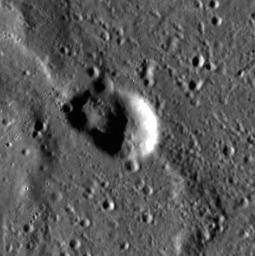
|
The End of Time
- Click the image above for a larger view
- Full-Res JPEG (1020 x 1024) (126.2 kB)
- Full-Res TIFF (1020 x 1024) (1.0 MB)
Caption:
You may have noticed that one of the details we give for each image is the Mission Elapsed Time, or MET, of when it was acquired. MET is the time, in seconds, since the MESSENGER mission began in 2004. As a testament to how long MESSENGER has been in space (over eight years!), the number of seconds has added up to over 250 million, and has come close to reaching the limit of how high the spacecraft clock can count. Thus in January, the MESSENGER team reset the clock, starting over at a time of 1,000 seconds. Why 1,000 seconds rather than zero? The MET clock was originally set to start counting 1,000 seconds before launch, so that launch was actually at an MET of 1,000 rather than zero; the clock reset follows that precedent.
Today's image was acquired at an "MET" of 129,781 seconds, or a day and a half after the count started over. This image shows an interesting crater in the Caloris basin. Craters of irregular shape are often thought to be formed from processes other than impact events, but this crater could be a cluster of several smaller craters or its shape could have been modified by the wrinkle ridge that crosses the scene from northwest to southeast. North is up in this image.
This image was acquired as a high-resolution targeted observation. Targeted observations are images of a small area on Mercury's surface at resolutions much higher than the 200-meter/pixel morphology base map. It is not possible to cover all of Mercury's surface at this high resolution, but typically several areas of high scientific interest are imaged in this mode each week.
Date acquired:
January 10, 2013
Image Mission Elapsed Time (MET):
129781
Image ID:
3302953
Instrument:
Narrow Angle Camera (NAC) of the Mercury Dual Imaging System (MDIS)
Center Latitude:
28.08°
Center Longitude:
144.6° E
Resolution:
28 meters/pixel
Scale:
This scene is approximately 28 km (17 mi.) across
Incidence Angle:
77.1°
Emission Angle:
0.7°
Phase Angle:
76.4°
Background Info:
The MESSENGER spacecraft is the first ever to orbit the planet Mercury, and the spacecraft's seven scientific instruments and radio science investigation are unraveling the history and evolution of the Solar System's innermost planet. Visit the Why Mercury? section of this website to learn more about the key science questions that the MESSENGER mission is addressing. During the one-year primary mission, MDIS acquired 88,746 images and extensive other data sets. MESSENGER is now in a year-long extended mission, during which plans call for the acquisition of more than 80,000 additional images to support MESSENGER's science goals.
For information regarding the use of images, see the MESSENGER image use policy .
Cataloging Keywords:
| Name | Value | Additional Values |
|---|---|---|
| Target | Mercury | |
| System | ||
| Target Type | Planet | |
| Mission | MESSENGER | |
| Instrument Host | MESSENGER | |
| Host Type | Orbiter | |
| Instrument | Mercury Dual Imaging System (MDIS) | |
| Detector | Narrow Angle Camera (NAC) | |
| Extra Keywords | Crater, Grayscale, Impact, Map, Radio | |
| Acquisition Date | ||
| Release Date | 2013-02-04 | |
| Date in Caption | 2013-01-10 | |
| Image Credit | NASA/Johns Hopkins University Applied Physics Laboratory/Carnegie Institution of Washington | |
| Source | photojournal.jpl.nasa.gov/catalog/PIA16784 | |
| Identifier | PIA16784 | |
